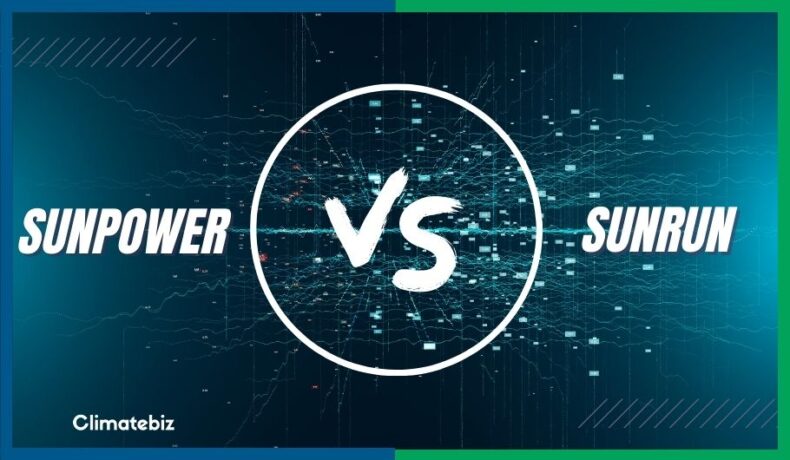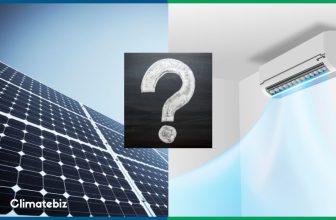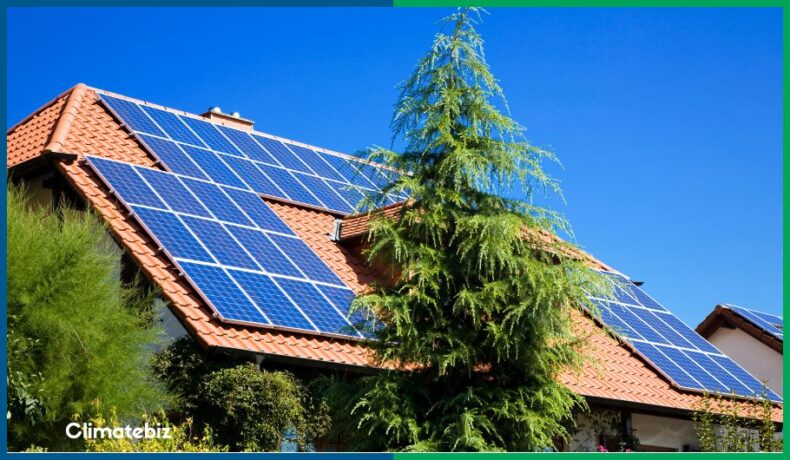
When combined, solar panels and trees get a bad rap — people view them as a recipe for low solar energy production. But you may be surprised to learn that they can work in harmony with each other.
Solar panels and trees are critical anti-global warming weapons that can co-exist while maximizing your solar potential. Blaming trees for delayed returns on your investment doesn’t paint the whole picture.
In this article, we tackle the real underlying issue, which is a phenomenon called shading.
What is it, and how can you deal with it?
Affiliate Disclaimer
Table of Contents
Does tree shading affect solar panel energy production?
The impact of shading greatly depends on your location and environmental conditions. It can result from an obstacle — not necessarily a tree — blocking the irradiation path to your solar cells.
Other sources of solar panel shading are clouds, adjacent infrastructures, and tall buildings.
Usually, a solar system’s planning phase will address potential root shading sources. Design engineers conduct a thorough analysis to ensure they place your panels so that they can produce maximum energy.
How much less energy will your solar panels produce if shaded?
Determining the impact of tree shading is more complex and involves a lengthy process and some analysis.
That said, there is no one-size-fits-all template to establish the answer to this question. Power losses from partial shading conditions (PSC) depend on PV array configuration, architecture, and shading patterns.
So how do you determine how much solar energy a panel will lose from tree shading?
Let’s begin by reviewing how a solar panel works.
Basic solar operations
The process begins with the sun emitting solar radiation toward the earth. The solar panel is a generator technology that captures irradiance — solar radiation per unit area or watts per meter square — and turns it into electric energy.

Types of PV arrays
Two researchers from the National Institute of Technology in India conducted a comprehensive simulation study of partial shading on a 5 x 5 PV array system. They used the following PV array configurations:
- Pure series string.
- Series-parallel.
- Honeycomb.
- Bridge-linked.
Those of you who know how to wire solar panels are probably familiar with the first two configurations on the list.

On the other hand, creating a honeycomb or bridge-linked PV array isn’t hard to imagine once you see how they look (see image below).
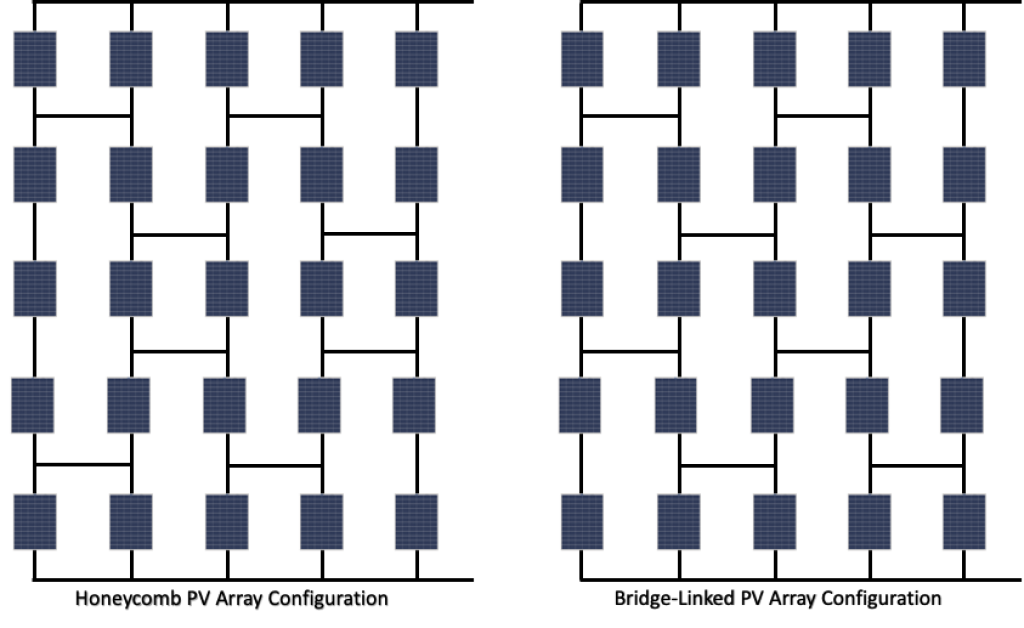
Types of partial shading conditions
These PV array configurations were simulated under a comprehensive set of partial shading conditions (PSC) such as:
- Uneven row shading.
- Uneven column shading.
- Diagonal shading.
- Random shading.
- Short and narrow.
- Short and wide.
- Long and narrow.
- Long and wide.
They even took it a step further and used the same PSCs on solar panels with bypass diodes to see how this technique improves PSC robustness.
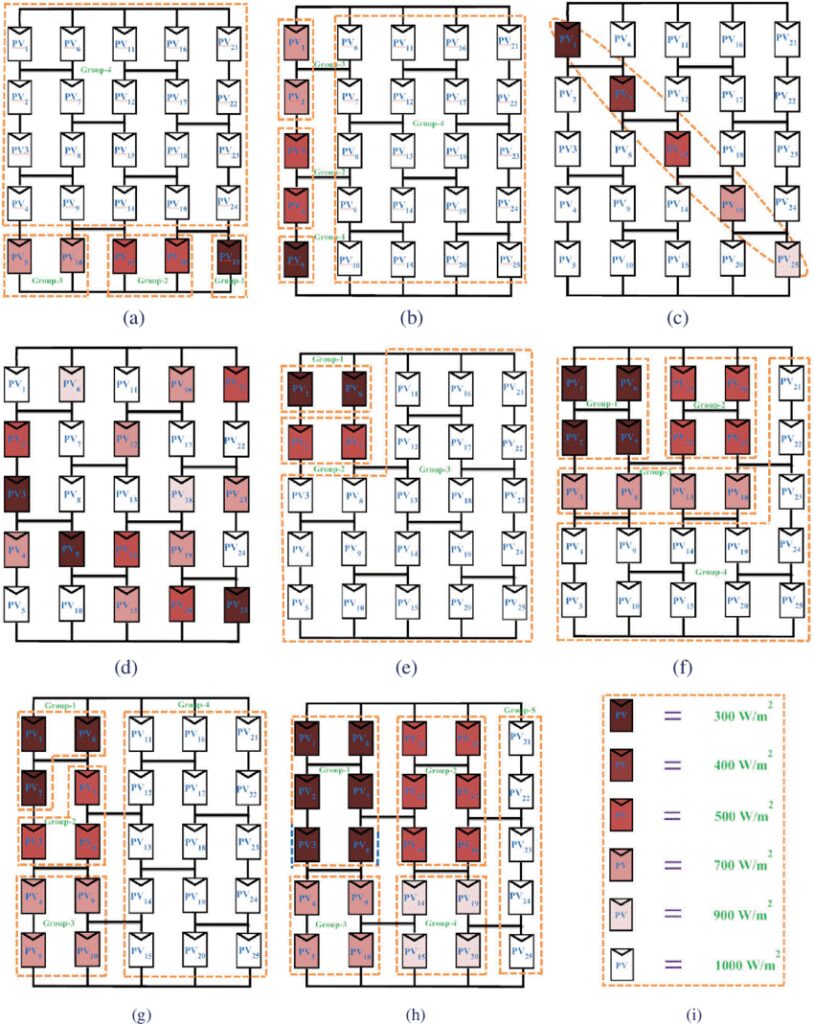
Source: Pendem, Suneel Raju & Mikkili, Suresh. (2018). Modeling, simulation, and performance analysis of PV array configurations to harvest maximum power under various Partial Shading Conditions.
Key takeaways
Here are our key takeaways from the above study:
- Power loss without bypass diodes: PV array configurations using panels without bypass diodes can lose around 20% to 50% of their peak power under various PSCs.
- Power loss with bypass diodes: Power losses of all array configurations decreased to 15%-40% when bypass diodes were used.
- Bypass diodes and resilience: A series PV array without bypass diodes is the least resilient type, losing at least 20% to 60% for almost all the PSCs. When bypass diodes are added, substantial benefits are seen. In one case, adding bypass diodes to a series array reduced power loss from 60% to 20%.
- Series string PV array performance: They perform the best under a short and narrow PSC (18% reduction).
- Series-parallel configuration: This configuration performs close to the highest PV array under all PSCs except short and narrow shading patterns. This proves why most PV arrays in the residential sector are wired in series-parallel.
- Honeycomb configuration: The honeycomb setup is the most promising array configuration under all PSCs.
Actionable advice for monitoring solar panel shading
For those of you who want actionable advice, we recommend two things:
Actual data gathering
Use this method if you’re comfortable playing the long game.
- Set up monitoring devices (camera, power meter, energy meter).
- Source some solar tools like a sun path chart.
- Check your weather forecasts daily.
- Start taking notes daily for an entire year.
Finally, create charts and graphs comparing daily, weekly, and monthly power output with detected shading phenomena.
If that doesn’t sound too fun, there is a more practical option, but it involves costs.
Use site evaluation tools
A solar pathfinder is a site analysis tool used by pros to analyze shading. However, going deep into how a solar pathfinder works isn’t the point of this article. If you’re interested in this topic, let us know in the comments below.
Should you cut your trees down?
By now, you should understand that solar panels and trees aren’t the real issues. Remember, shading is a concern that the site planning phase addresses. Therefore, you don’t need to cut your trees down.
Instead, we recommend that you trim any obstructing tree branches, clean off any debris, and maintain your solar panels to maximize solar output.
This will help maximize your panels’ exposure to sunlight without resorting to drastic measures like cutting down entire trees.
Ways to reduce the effects of tree shading on solar panels
PV array system design
Ensure that your current system is at least in a standard series-parallel configuration. We already mentioned that this PV array configuration hits the sweet spot between mitigating shading effects and complexity.
For the thrill-seekers out there who want a bit of risk in exchange for higher shading robustness, you can call your installer and ask if they can reconfigure your current setup into a honeycomb configuration.
Buy panels with bypass diodes
We recommend reconfiguring your array to series-parallel if you own a medium to a large solar system tied only in a series string. If this is not an option, please check your solar panel junction box or manual to confirm if they have bypass diodes.
Multiple round busbars over ribbon busbars
One of the solutions solar developers created to increase solar panel robustness is by increasing the busbar count in solar panels and making them round instead of flat.
Using round busbars instead of flat ones (a.k.a. ribbon busbars) enable second-hand use of irradiance, making it available to parts of your solar panel affected by shading.
The bottom line: multiple round busbar solar panels — like the BougeRV 200W 9BB model — help reduce shading effects.

Source: Trina Solar.
Monocrystalline over polycrystalline for shading robustness
Another change you can make is choosing monocrystalline panels over polycrystalline.
A study discussing the effect of shading on PV panel technology found that power loss from shading increases by 50% when using polycrystalline over monocrystalline.
Think of using shade analysis software
Should you consider shade analysis software? If you’re still in the planning phase of your solar project and the benefits outweigh the cost and learning curve, go for it.
Let’s start with the freeware you can use.
Right now, Google offers free online software known as Project Sunroof. This software can perform a complete shading analysis.
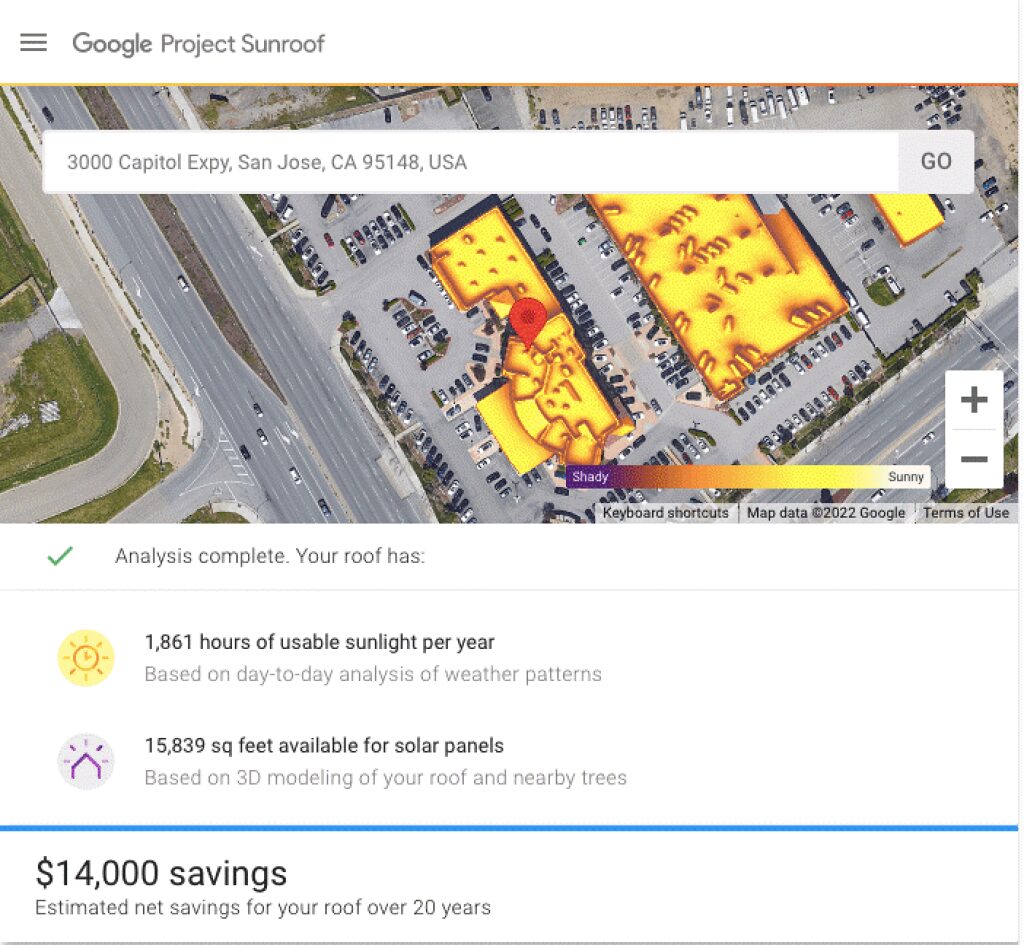
For those of you who are looking for industry-grade shade analysis software, try PVsyst or Helioscope. Each software tool costs around $1,000/year and offers comprehensive features.
These are the commonly used tools in the industry to plan, study and implement PV systems.
Electric consumers are empowered now more than ever before
Generous global policies remain the primary driver behind the growth and adoption of solar deployment worldwide across all sectors. Shares of residential PV generation are at their highest (28%), while solar utility generation contributes 52%.
What does this mean?
Consumer empowerment. Allowing the consumer to choose how they source their electricity through enticing government programs, incentives, and technology (e.g., electricity consumption monitoring and feedback).
All the more reason to equip the general public with advanced solar concepts such as shading.
Final thoughts
The key takeaway: you can keep both solar panels and trees without sacrificing the returns on your investment. Moreover, advanced technology and information allow us to explore options that fully utilize the panels.
Hopefully, we’ve reassured you that letting your trees and solar panels co-exist peacefully is possible. If you have any further questions, please reach out to us on Twitter or in the comments section below.

